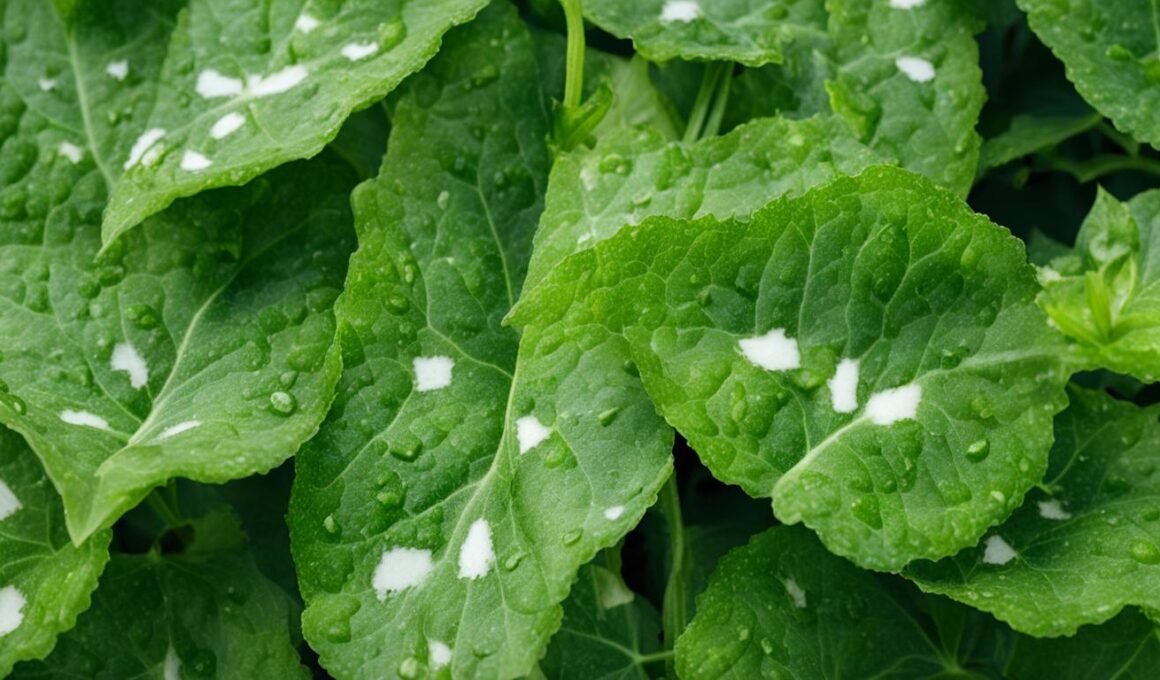If you’ve noticed that the leaves of your cucumber plants are turning white, there are a few potential causes to consider. One common culprit is powdery mildew, a fungal infection that can turn the leaves a white or gray color and cause them to curl up and die. Another possible cause is iron chlorosis, which occurs when the soil is lacking in iron and causes the leaves to turn pale and develop yellow spots. Excess moisture, overcrowding, and leafhopper infestations can also lead to white spots on cucumber leaves. Thankfully, there are several remedies you can try to fix this issue and revive your cucumber plants.
Before we dive into the solutions, it’s important to understand the underlying causes of white spots on cucumber leaves. By identifying the root issue, you can apply the appropriate fix and prevent future problems. In the next sections, we’ll explore the most common cause, powdery mildew, and other factors that may contribute to white spots on cucumber leaves. Then, we’ll discuss how you can revive your cucumber plants and ensure their long-term health.
Powdery Mildew: The Most Common Cause of White Spots on Cucumber Leaves
Powdery mildew is the most common reason for cucumber leaves turning white. It is a fungal infection that thrives in warm, humid conditions and can quickly spread throughout the cucumber plant. The leaves will develop white, powdery spots and may also curl up and die.
Another viral infection, cucumber mosaic virus (CMV), can also cause white spots and distortion of the leaves.
To treat powdery mildew and CMV, neem oil is a popular natural remedy that can effectively control the spread of the infection. Neem oil has antifungal and insecticidal properties, making it a versatile solution for various garden problems.
Other Causes of White Spots on Cucumber Leaves
In addition to powdery mildew and viral infections, there are several other factors that can lead to white spots on cucumber leaves.
- Excess moisture in cucumber plants: Overwatering or poor drainage can result in excess moisture in the soil, which leaches nutrients and causes white or yellowing leaves.
- Leafhoppers on cucumber plants: These tiny insects feed on the sap of cucumber plants, causing white spots and damage to the leaves.
- Preventing blanching in cucumbers: Insufficient sunlight can lead to incomplete photosynthesis and pale or white leaves. This blanching can be prevented by ensuring adequate exposure to sunlight and providing proper spacing between plants.
To prevent excess moisture, avoid overwatering and ensure proper drainage in your cucumber garden. Regularly inspect and address any leafhopper infestations to minimize damage to the leaves. To prevent blanching, choose a sunny location for your cucumber plants and provide sufficient spacing to allow for optimal sunlight absorption. By addressing these other causes of white spots on cucumber leaves, you can help maintain the overall health and appearance of your plants.
Are White Spots on Tomato Leaves Related to the White Leaves on Cucumber Plants?
Yes, the causes and fixes for white spots on tomato leaves could be related to the white leaves on cucumber plants. Both could be caused by fungal diseases such as powdery mildew. To address this issue, proper ventilation, pruning, and applying fungicides may help prevent and treat the white spots.
Reviving Your Cucumber Plants: Fixing White Leaves and Preventing Future Problems
If you’ve noticed white spots on your cucumber leaves, don’t panic. There are several steps you can take to revive your plants and prevent future problems. One common issue that causes white leaves on cucumber plants is powdery mildew, a fungal infection. To combat this, you can use neem oil, a natural and effective treatment. Applying neem oil directly to the leaves not only helps control the spread of the infection but also repels other insect pests. This integrated approach can help fix the white leaves and promote healthier growth.
Proper watering practices also play a crucial role in preventing nutrient deficiencies and excess moisture-related issues that can lead to white spots on the leaves. Avoid overwatering your cucumber plants and ensure consistent moisture levels in the soil. By maintaining proper hydration, you can effectively prevent these problems from occurring.
In addition to treating the symptoms, implementing integrated pest management (IPM) techniques can help control leafhopper populations and prevent further damage. Remove any infected leaves promptly to prevent the spread of diseases. Attracting beneficial insects, such as ladybugs or lacewings, to your garden can help naturally control leafhoppers and other pests. By taking these proactive measures, you can maintain healthy cucumber plants and prevent future white spots on the leaves.
To minimize the risk of diseases and ensure the long-term health of your cucumber plants, consider planting disease-resistant varieties. These varieties are specifically bred to withstand common cucumber plant diseases and are less likely to develop white spots. Additionally, providing sufficient spacing between plants and ensuring they receive adequate sunlight will promote air circulation and reduce the risk of fungal infections. By embracing these preventative measures, you can enjoy a thriving cucumber garden and prevent the leaves from turning white.









